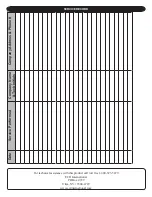
15
OPERATING INSTRUCTIONS
Use caution when vacuuming in the chamber
area. Damage to chamber could result.
CAUTION
!
It is recommended to replace the nozzle at the start of each
heating season. Lubricate the burner motor and circulator
motor - if required - with a few drops of a good grade of
light motor oil. Do not over oil. Have a competent service
person service the burner and check the controls and check
the electrodes for carbon or cracks in the insulators. Burn
-
ers should be adjusted to produce the conditions shown in
"Startup and Adjustment of Oil Burner."
CLOSING THE BURNER SWING DOOR
Swing burner and door to the right until insulation is
1.
slightly compressed and the stud is exposed.
Attach nut to the stud and tighten it until the built in stop
2.
contacts the mounting door.
Reconnect oil line to burner.
3.
Replace lower jacket panel, and tighten the screws.
4.
Connect the power cable at the factory supplied burner
5.
electrical disconnect.
Turn on power to boiler and bleed oil line.
6.
MAINTENANCE PROCEDURES
Before seasonal start up it is advisable to have a compe
-
tent service agency check the boiler for soot and scale in
the flues, change oil filter and nozzle, clean the burner and
readjust burner input rate to maintain proper operation and
high operating efficiency.
On steam boilers make certain the boiler is filled to the wa
-
ter line as indicated in
Figure #14
. The gauge cocks should
be normally open. To remove dirt from the gauge glass the
petcock may be opened to flush out the glass.
Discharge may be boiling hot water.
WARNING
!
The radiator valves on a one-pipe steam system must be
either wide open or tightly shut. Do not attempt to regulate
room temperature by partially closing the radiator valve.
Air vents on steam radiators and the supply main release
air from the system. If radiators do not heat satisfactorily,
make sure the air vents are clean and operational.
The lever of the pressure relief valve on the boiler
(
Figure
#14
)
should be operated periodically to make sure that it
is functioning properly.
Refill boiler to its normal water line.
C. Primary Control and Flame Sensor -
To Check:
Flame Failure
1.
- simulate by shutting off oil supply with
hand valve while burner is on. Sixty seconds after flame
-
out, the safety switch locks out, ignition stops, motor stops
and oil valve - when used - closes. To restart, open oil
supply valve and reset safety switch.
Ignition Failure
2.
- With burner off, close oil supply valve
and run through start-up procedure, The safety switch
should lock out as in flame failure.
Power Failure
3.
- Turn off main power supply switch while
burner is operating. When burner stops, restore power
and burner should start. If operation is not as described
as above, check wiring and controls.
Preventative maintenance of an oil fired boiler reduces op
-
erating costs. The boiler and vent pipe should be inspected
for accumulation of soot or scale deposits periodically but
at least once every year before the start of each heating
season. When soot is present on the section walls and flu
-
eways, improper combustion will result, causing additional
sooting and scaling until flueways are completely closed.
To remove soot and scale from the flueways, remove top
jacket panel, top clean-out plate, open burner swing door.
(
Figure #14
)
OPENING THE BURNER SWING DOOR
Turn off power to boiler and allow boiler to cool down.
1.
Disconnect power cable at factory supplied burner elec
-
2.
trical disconnect.
(
Figure #14
)
Loosen screws on the sides of the lower front jacket
3.
panel.
(Figure 6)
Pull the bottom part of the lower front
panel forward and lift the lower front panel up and off
the boiler.
(
Figure #14
)
Close oil valve
4.
(
Figures #12 - #13
)
and disconnect oil
line from burner.
IMPORTANT:
Do not open swing door with
oil line attached.
Remove nut from swing door stud on right hand side of
5.
door.
Swing open burner and door to the left. Using a flue
6.
brush, brush the soot and scale into the combustion
space where it can be removed through the swing door
opening.










































